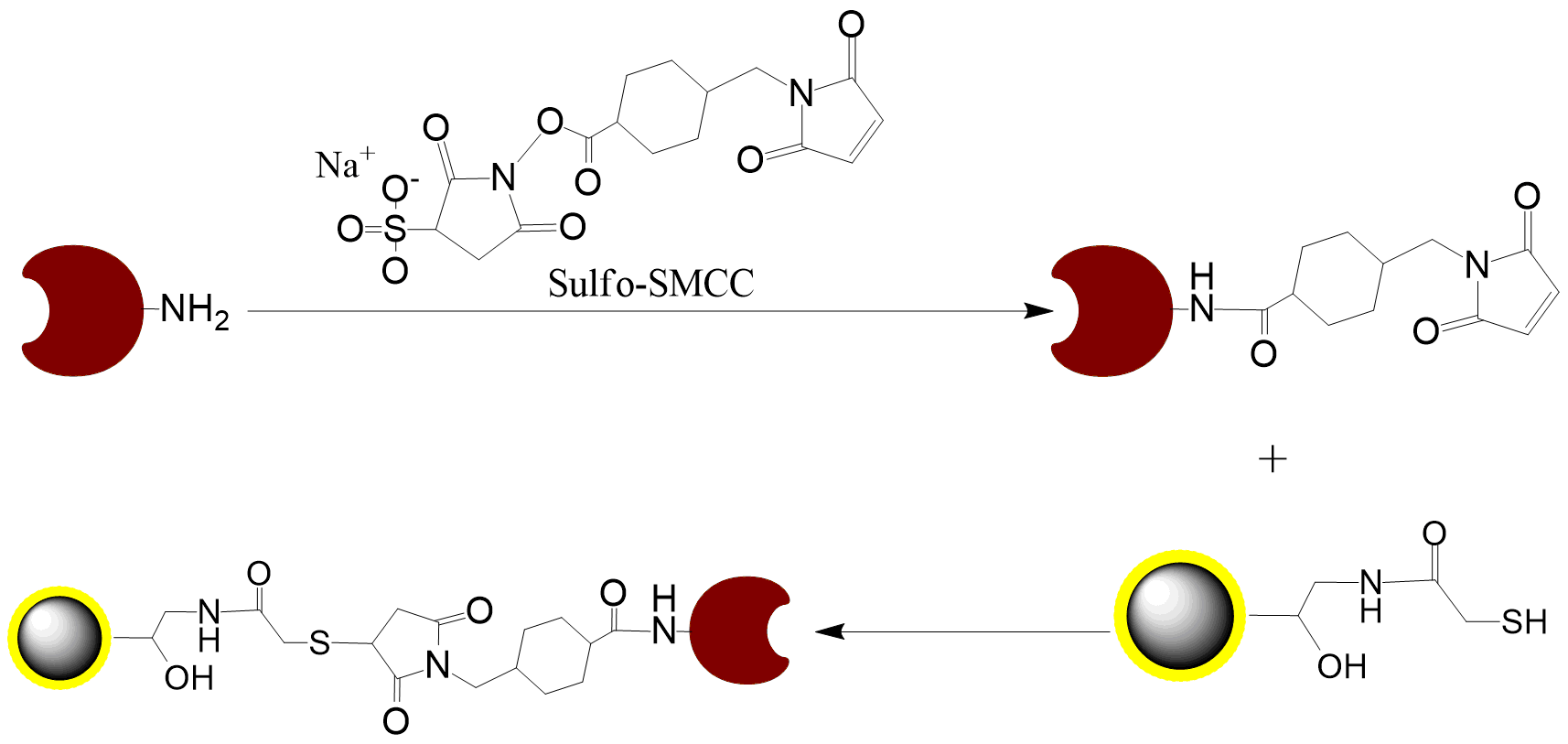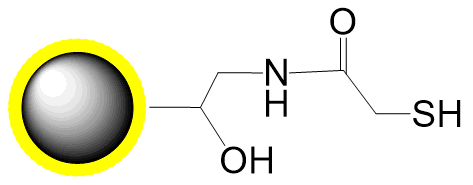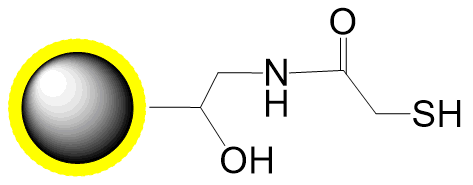|
Ordering information |
|||
|
Name |
Cat. No. |
Vol. |
Scheme |
|
G-SH |
PMG033-2 |
2 ml |
|
1. Overview
PuriMag™ G-SH Thiol-Functionalized Magnetic Nanoparticles are uniform, polymer-coated superparamagnetic nanoparticles. Their hydrophilic surface ensures excellent dispersibility, low non-specific adsorption, and easy handling in diverse buffers.The thiol functional group (–SH), characterized by a sulfur atom bonded to hydrogen, is denoted by suffixes "-thiol" or prefixes "mercapto-" / "sulfanyl-". Thiols exhibit high affinity for soft metals. These beads are specifically engineered for coupling with SMCC-modified proteins/peptides (sulfosuccinimidyl 4-(N-maleimidomethyl)cyclohexane-1-carboxylate).
SMCC Chemistry:
-
Contains an amine-reactive NHS ester (forms stable amide bonds with primary amines at pH 7–9).
-
Contains a thiol-reactive maleimide group (forms stable thioether bonds at pH 6.5–7.5).
Advantages:
-
Rapid, straightforward preparation without repetitive pipetting/centrifugation.
-
Ideal for coupling both large proteins and small peptides.
-
Suitable for magnetic separation applications: affinity enrichment, protein purification, immunoprecipitation, cell sorting.
Features & Benefits:
-
Optimized Coupling: High efficiency at pH 7.2 for 12 h
-
Stable covalent bonds with minimal ligand leakage
-
Generates reusable immunoaffinity matrices
-
Low non-specific binding
-
Applications: Antibody/protein/peptide/DNA/RNA purification; cell sorting; immunoprecipitation
-
Convenient and rapid coupling
Schematic Diagram of Coupling Mechanism:

2. product description
|
Product Specifications |
|
|
Description |
Polymer coated Fe3O4 nanoparticles |
|
Particle Size |
200 nm |
|
Number of Beads |
~1.7×1010 beads/mg |
|
Matrix |
Proprietary polymer |
|
Functional group |
Sulfhydryl group |
|
Group density |
~300 µmole / g of Beads |
|
Magnetization |
60~70 EMU/g |
|
Formulation |
10 mg/ml suspension in ethanol |
|
Stability |
pH 3.5~10, 4~80 ℃, most organic solvents |
|
Storage |
1 year at 4~8 ℃. Do not freeze. |
3. Instructions for Use
Note: The following protocol exemplifies coupling proteins and/or peptides to PuriMag™ Thiol-Activated Magnetic Nanoparticles.
Strong optimization of bead quantity is recommended. Insufficient ligand loading may increase non-specific binding, while excessive loading may cause steric hindrance. For affinity matrices, use 1–50 mg protein or 0.1–5 mg peptide per gram beads. Scale proportionally as needed.
A. Required Materials
Magnetic Racks:
For 12×1.5–2 mL tubes (Mrack02)
For 2×50 mL or 2×15 mL tubes (Mrack03)
Buffers/Reagents:
Coupling Buffer: PBS, pH 7.2
SMCC (Sulfosuccinimidyl 4-[N-maleimidomethyl]cyclohexane-1-carboxylate) or Sulfo-SMCC
B. Protein/Peptide Preparation:
1.Dialyze protein/peptide against 50× volume PBS (pH 7.2, 5 mM EDTA).
2.Add SMCC to protein solution and mix thoroughly.
*Note: Prepare 3.7 mg/mL SMCC in DMF. If undissolved, incubate tube in 50°C water bath. Add:
100 μL SMCC solution to 1 mL protein (10 mg/mL) or
50 μL SMCC solution to 1 mL protein (<1 mg/mL).*
3.Incubate 2 h at 4°C or 30 min at RT.
4.Remove free SMCC/unmodified protein via Sephadex G15 chromatography. Elute with PBS. Monitor elution at 206 nm.
C. Bead Preparation:
*Note: Store beads as 10 mg/mL suspension in PBS at 4°C. Vortex vigorously before use.*
1.Vortex bottle to resuspend thiol beads.
2.Transfer 100 μL beads (10 mg/mL) to tube. Place on magnetic rack for 1–3 min. Discard supernatant while tube remains on rack.
3.Resuspend beads in 200 μL PBS. Stand 2–3 min at RT. Return to rack for 1–3 min. Discard supernatant on rack.
4.Repeat Step 3 twice.
5.Incubate beads with 1 mL DTT (3 mg/mL, ~20 mM) at RT for 15 min. Wash 3× with PBS.
6.Mix reduced beads with protein-SMCC conjugate. Incubate at 4°C for 12 h.
7.Wash beads and resuspend in desired buffer.
(This product is for research use only!)






